Biosep™ is an aerobic biological treatment process treating municipal and industrial effluents.
Overview
Effective, Compact, Easy to Use
An innovative solution developed by Veolia Water Technologies, Biosep™ combines two proven technologies:
- Biological treatment using activated sludge
- Membrane filtration
Biosep™ produces very high quality water, fully compliant with the highest standards for water reuse for irrigation and industrial applications.
With more than 120 references worldwide, Biosep™ is recommended for:
- Significant reduction of carbon, nitrogen and phosphorus pollution
- High and simultaneous removal of bacteria depending on the treated water, completed by downstream disinfection.
Biosep™ is sold under the Neosep™ trademark in Japan, the United States, Australia and New Zealand.
Biosep™ for Industries
The Biosep™ technology meets the specific requirements of industrial clients, when they are confronted with the following problems:
- Concentrated effluents
- High discharge standards and treatment efficiency
- Upgrade/refurbish existing facilities
- Water reuse
- Limited space available
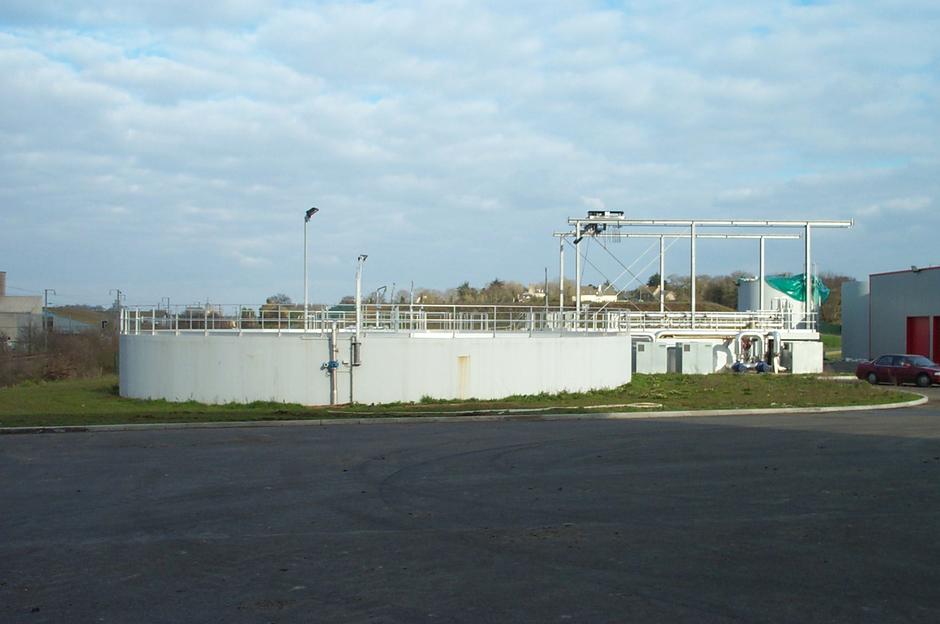
Biosep™ achieves high-performance treatment of industrial effluents for the following markets:
- Food and beverage
- Pharmaceuticals
- Cosmetics
- Chemicals
- Petrochemicals
- Biofuels
- Landfill leachate
- Pulp and paper
- Automotive
- Textiles…
Biosep™ for Municipalities
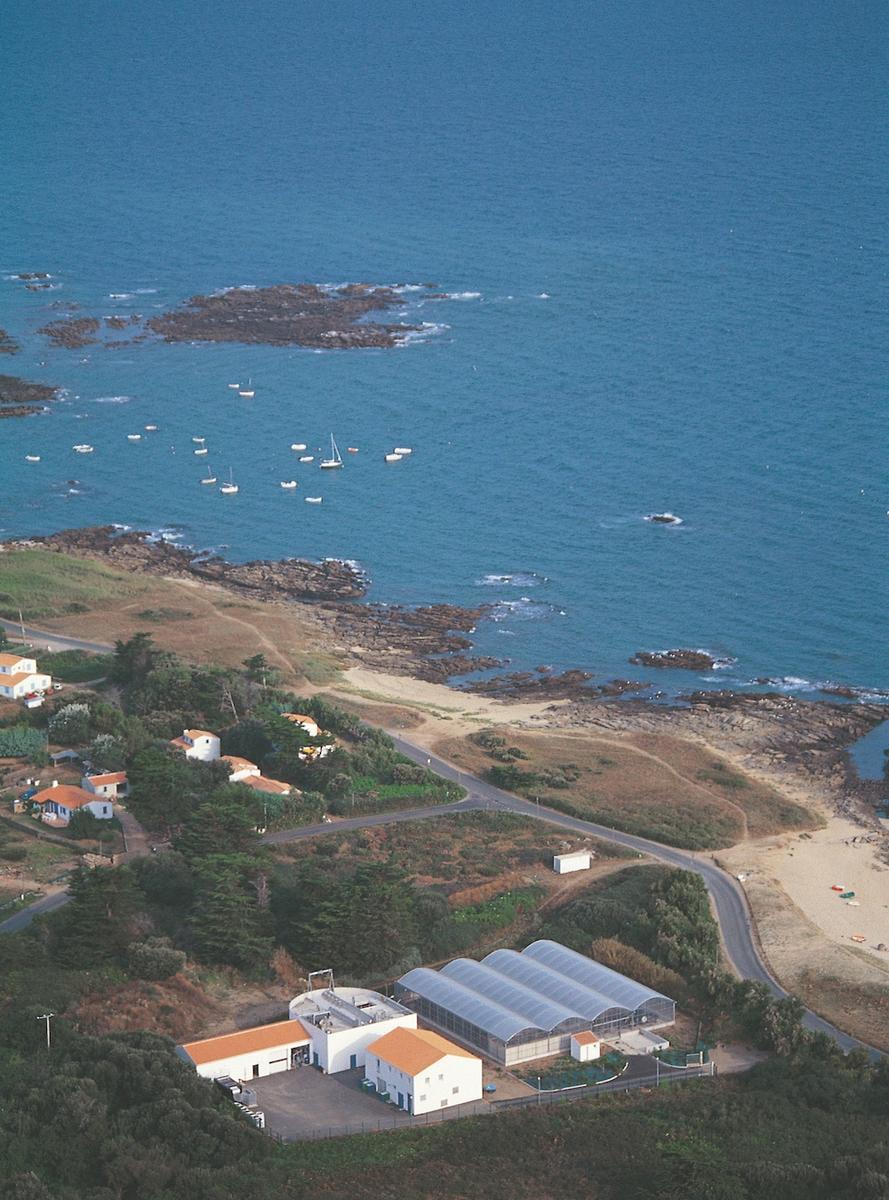
Biosep™ is a membranes bioreactor developed by Veolia. It is an activated sludge process in which membranes provide the clarification.
Biosep™ is suitable for municipal clients who:
- Must adhere to high discharge standards (environmentally sensitive areas)
- Want to achieve high wastewater treatment efficiency
- Have a limited area to operate in
- Want to reuse water for irrigation, for use in sprinkler systems or for recharging aquifers
Biosep™ is ideal for meeting the requirements of municipal clients who experience sharp seasonal load variations (touristic areas). Biosep™ also enables the purified water to be released directly back into environmentally sensitive areas, thereby avoiding the construction of long outfalls.
Advantages of the Biosep™ Process for Municipal Clients:
- Membranes provide clarification; the load applied can be significantly higher than in a classic activated sludge. For the same load, the reactor is smaller so, the plant is more compact
- Thanks to its compactness, the structure can be easily confined, and odor and noise nuisances are controlled
- On mixed wastewater, Biosep™ is free of risks related to fibrous sludge bulking
- By undergoing an additional UV treatment, the water treated by Biosep™ can be reused in irrigation, sprinkler systems or for recharging aquifers
- Biosep™ is ideal when refurbishing existing sites, thanks to its compact design and the fact that it can be easily installed in existing tanks
Some municipal references:
- Saint Laurent du Var, France (2013), 110,000 PE
- Disneyland Paris, France (2013), 20,000 PE
- Saint Nazaire, France (2012), 75,000 PE
- Monnaie, France (2012), 5,600 PE
- Achères DERU - Seine Aval, France (2011), 110,000 PE
- Port Leucate, France (2011), 45,000 PE
- Ashbourne, Ireland (2006), 5,000 PE
- Avranches, France (2006), 40,000 PE
- Rousset, France (2006), 12,000 PE
- Saint-Jouan des Guérêts, France (2006), 7,500 PE
Features & Benefits
Biosep™ provides water of exceptional quality:
- High reduction of carbon and nitrogen pollution
- High suspended matter removal
- High bacteria removal rate
Biosep™ has many advantages compared with conventional biological treatment of effluents by activated sludge:
- Compact system
- No final clarification (no risk of sludge loss, performance is independent of the sludge index)
- With a similar load, the biological reactor is smaller
- High COD removal, including slowly biodegradable COD thanks to a high "sludge age" and membrane separation
- Reduced reagent consumption in phosphorus elimination
- Thickener may also be removed because of the high concentration reached in the biological reactor
Applications
Thanks to its tried and tested design, Biosep™ offers a highly compact water treatment solution, enabling the treatment to be carried out with high concentrations of biomass (8 to 12 g SS/l). Biosep™ is a solution suitable for compact installations.
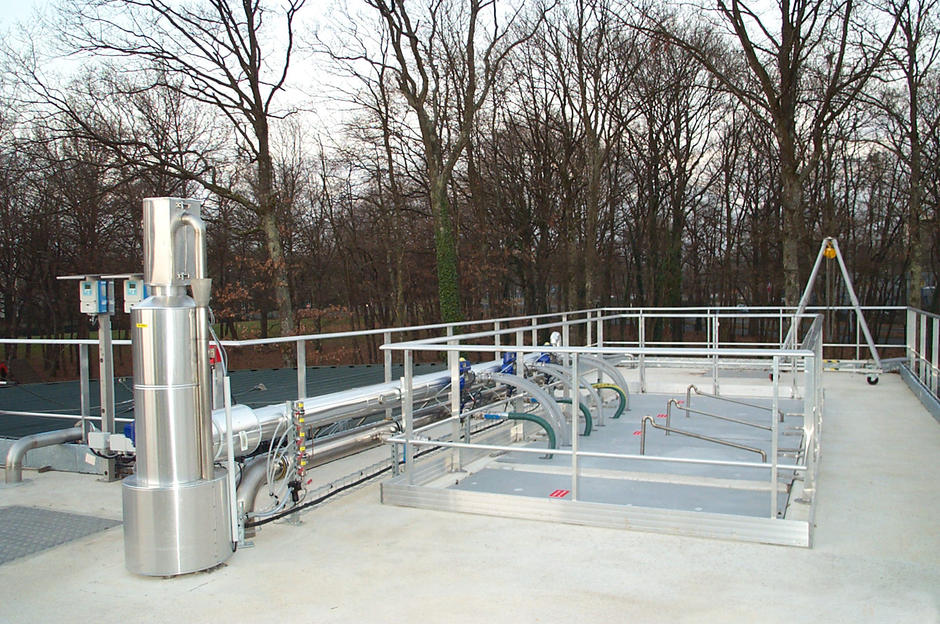
Operating Principle
Biosep™ uses a biological tank and a membrane system which can be presented in different configurations depending on the application and local conditions. In the immersed version (the most common), these modules are directly immersed in the biological tank or in a separate tank.
- After pre-treatment (e.g. screening sand removal), raw water flows into the biological tank where carbon, nitrogen and phosphorus pollutants are removed.
- Membrane filtration then separates the water from the activated sludge: the treated water is drawn off using a low-pressure (< 0.6 bar) pump. The sludge retained by the membrane creates a sludge cake on the outside membrane surface. The excess sludge is directly removed from the biological tank for dewatering.
- Sustainable membrane filtration performance is key to the process; this is based on different automated functions which provide for membrane washing and backwashing: backwash, air injection and chemical cleaning (usually bleach and citric acid). This is Veolia knowledge and expertise.
An Optimized and Simplified Treatment Line
By replacing the conventional gravitational clarification stage, membrane separation goes away with the limitations surrounding sludge settling: discharge quality is completely controlled.
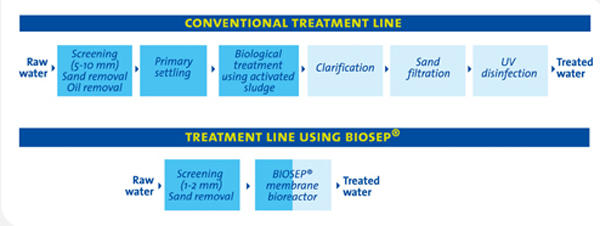
A physical barrier at the core of the system
The choice of the filtration membranes (organic flat sheet or hollow fiber membranes) is an important factor.
The main selection criteria are:
- Sustainable mechanical characteristics (integrity maintained over time)
- Sustainable hydraulic performances
- Hydraulic flow recovery after a peak
- Related operational costs controlled
Veolia has no partnership established with a particular membrane supplier, which allows us to choose and provide the most suitable membrane, depending on technological evolution and feedback from operational sites. Veolia has more than 120 references, both municipal and industrial, with more than a dozen membrane suppliers.
Performances
High quality treated water
The water quality obtained by Biosep™ is fully compliant with stringent environmental standards and meets municipal and industrial requirements too.
Biosep™ achieves high removal of carbon and nitrogen pollution and retains almost all of the suspended matter, with performance unmatched until today. It remains stable whatever the load variations. Disinfection of the treated water is provided by the integrated membrane filtration step. Additional disinfection may be necessary depending on the guarantees required.
Efficient treatment of municipal and industrial effluents
Examples of performance for municipal effluent:
| PERFORMANCES | ||
|---|---|---|
| Biological Treatment | ||
| COD | ≥ 75-90 % | ≤ 30-50 mg/l (according to hard COD) |
| BOD5 | ≥ 80-95 % | ≤ 5-25 mg/l |
| SS | ≥ 90-95 % | ≤ 5 mg/l |
| TN (Total Nitrogen) | ≥ 70-80 % | ≤ -5-20 mg/l |
| TP (Total Phosphorus) | ≥ 80-90 % | ≤ -1-10 mg/l |
| Disinfection | ||
| Total coliforms | 4-5 log | |
| Heat tolerant coliforms | 4-5 log | |
| Faecal streptococci D | 4-5 log | |
Nothing to see, Nothing to smell, Nothing to hear
With its innovative and compact design, Biosep™ is easy to install in any site without environmental impact, odor and noise nuisances.
Services
Since 1991, Veolia Water Technologies, Veolia's Technical Department and Veolia's R&D center (Veolia Research and Innovation) have gained a unique level of expertise in the membrane bioreactor (MBR) field.
The Result of Veolia Research
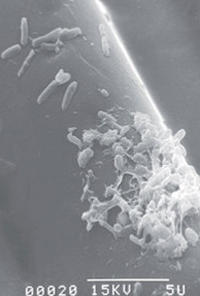
ARAMIS, the expertise center dedicated to membrane technologies and applications.
Its overall objectives are to:
- Evaluate membrane performance: retention rates, hydraulic and mechanical properties, to choose the right suppliers;
- Carry out membrane autopsies: retention, hydraulic properties, fouling identification;
- Define optimal operating conditions, efficient washing.
Veolia Water Technologies’ Expertise
| 1991 | First tests on membrane bioreactors |
| 1993 | Biosep™ industrialisation |
| 1995 | First industrial contract: "Les Epesses" landfill (France) |
| 1999 | First municipal contract: Perthes-en-Gâtinais - France |
| 2003 | Inauguration of the Membrane Expertise Center: ARAMIS |
| 2004 | Launch of the new standard filtration units: Biosep™ Pack |
| Since 2005 | World leader in design, build and operation of membrane bioreactors |
This expertise provides our customers with modular computerized solutions, assisting operation.


